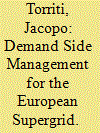| Srl | Item |
| 1 |
ID:
125529


|
|
|
|
|
| Publication |
2013.
|
| Summary/Abstract |
Demand response is believed by some to become a major contributor towards system balancing in future electricity networks. Shifting or reducing demand at critical moments can reduce the need for generation capacity, help with the integration of renewables, support more efficient system operation and thereby potentially lead to cost and carbon reductions for the entire energy system.
In this paper we review the nature of the response resource of consumers from different non-domestic sectors in the UK, based on extensive half hourly demand profiles and observed demand responses. We further explore the potential to increase the demand response capacity through changes in the regulatory and market environment.
The analysis suggests that present demand response measures tend to stimulate stand-by generation capacity in preference to load shifting and we propose that extended response times may favour load based demand response, especially in sectors with significant thermal loads.
|
|
|
|
|
|
|
|
|
|
|
|
|
|
|
|
| 2 |
ID:
112302


|
|
|
|
|
| Publication |
2012.
|
| Summary/Abstract |
The prospect of a European Supergrid calls for research on aggregate electricity peak demand and Europe-wide Demand Side Management. No attempt has been made as yet to represent a time-related demand curve of residential electricity consumption at the European level. This article assesses how active occupancy levels of single-person households vary in single-person household in 15 European countries. It makes use of occupancy time-series data from the Harmonised European Time Use Survey database to build European occupancy curves; identify peak occupancy periods; construct time-related electricity demand curves for TV and video watching activities and assess occupancy variances of single-person households.
|
|
|
|
|
|
|
|
|
|
|
|
|
|
|
|
| 3 |
ID:
179700


|
|
|
|
|
| Summary/Abstract |
The introduction of Time of Use (ToU) tariffs may affect residential electricity consumers differently depending not only on their financial position but also time availability. The aim of this paper is to identify socio-demographic groups which may be financially advantaged or disadvantaged by the introduction of ToU tariffs. Assuming no behavioural change, we impose ToU tariffs on UK half hourly smart meter data and the synthetic demand profiles for different household composition generated using the 2014–2015 UK Time Use Survey data and optimisation of energy consumption per activity against the smart meter data. The distributional effects of ToU tariffs are obtained for customer segmentation and socio-demographic groups, and presented in terms of peak to off-peak ratios and impacts on the synthetic demand profiles. Findings on the distributional effects of ToU tariffs reveal regional differences (e.g. positive effects for high income groups in London) and household composition similarities (e.g. positive effects for households with children not in the high-income group).
|
|
|
|
|
|
|
|
|
|
|
|
|
|
|
|
| 4 |
ID:
117246


|
|
|
|
|
| Publication |
2013.
|
| Summary/Abstract |
The recent policy discussion in the UK on the economic case for demand response (DR) calls for a reflection on available evidence regarding its costs and benefits. Existing studies tend to consider the size of investments and returns of certain forms of DR in isolation and do not consider economic welfare effects. From review of existing studies, policy documents, and some simple modelling of benefits of DR in providing reserve for unforeseen events, we demonstrate that the economic case for DR in UK electricity markets is positive. Consideration of economic welfare gains is provided.
|
|
|
|
|
|
|
|
|
|
|
|
|
|
|
|
| 5 |
ID:
114296


|
|
|
|
|
| Publication |
2012.
|
| Summary/Abstract |
Gaining public acceptance is one of the main issues with large-scale low-carbon projects such as hydropower development. It has been recommended by the World Commission on Dams that to gain public acceptance, public involvement is necessary in the decision-making process (WCD, 2000). As financially-significant actors in the planning and implementation of large-scale hydropower projects in developing country contexts, the paper examines the ways in which public involvement may be influenced by international financial institutions. Using the case study of the Nam Theun 2 Hydropower Project in Laos, the paper analyses how public involvement facilitated by the Asian Development Bank had a bearing on procedural and distributional justice. The paper analyses the extent of public participation and the assessment of full social and environmental costs of the project in the Cost-Benefit Analysis conducted during the project appraisal stage. It is argued that while efforts were made to involve the public, there were several factors that influenced procedural and distributional justice: the late contribution of the Asian Development Bank in the project appraisal stage; and the issue of non-market values and discount rate to calculate the full social and environmental costs.
|
|
|
|
|
|
|
|
|
|
|
|
|
|
|
|